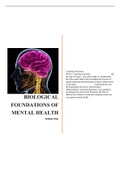Learning Outcomes:
Week 1: learning outcomes By
the end of Topic 1 you will be able to: Understand
how the neural tube forms including the process of
neural induction and formation of major subdivisions
of the brain Understand the key
developmental processes: proliferation,
differentiation, neuronal migration, axon guidance,
synaptogenesis and circuit formation Be able to
discuss how defects in neurodevelopment processes
BIOLOGICAL can impact mental health
FOUNDATIONS OF
MENTAL HEALTH
WEEK ONE
, Introduction to Brain Anatomy
Topic 1: Overview of CNS Development Part One
Introduction
The levels of neural development
The systems level: changes in size and shape in the development of
nervous system – ‘morphogenesis’
The cellular level: ‘differentiation’ from progenitors to mature neurons
Developmental disorders that affect mental health
We can think of neural development as taking place on two levels, namely, a
‘systems’ level and a cellular level. In this topic we will first consider the
systems level, looking at the changes in size and shape that occur during the
embryonic development of the nervous system. This process is called
morphogenesis.
We will describe changes at the cellular level that allow cells to change from
dividing progenitors into mature neurons with complex morphologies,
interconnected in circuits. This process is called differentiation, in the final
section we will show the relevance of each stage of neural development to
mental health by outlining he disorders that can result from defects that arise in
specific developmental events, with examples.
Overview of human development
In humans, development begins with fertilisation of the egg, which cleaves to give rise to a ball of cells called
blastocyst. Implantation of the embryo into the uterine wall occurs at the end of the first week. And further
development generates a two-layered embryonic disc, consisting of hypoblast and an epiblast. At the end of the
second week, the process of gastrulation transforms this disc into a three-layered structure consisting of three
so-called ‘germ’ layers – the ectoderm, mesoderm and endoderm-which give rise to all the tissues of the body.
,By the end of the third week, the process of neurulation begins, which creates the embryonic nervous system. In
weeks 4-5, the embryo starts to be recognisable, with a head, tail and some of the embryonic structures that will
be present in the adults, such as the limb buds, which grow into the limbs. This stage is often called the ‘tail
bud’ stage.
In humans, the second month of gestation is referred to as the embryonic period, during which the major organ
system start to form. And months three to nine in the foetal period, which is mainly concerned with growth.
Large amounts of cell proliferation take place, a process which is particularly important for the brain.
Neural induction
Ectoderm is induced to become neural tissue by the underlying
mesoderm.
In the process of neurulation, morphogenic and genetic
changes transform section of the ectoderm into the neural tube.
Further development of the nervous system involves the
ectoderm, which develops under the influence of signals from
the underlying mesoderm, a process called neural induction.
During this process, a portion of ectodermal germ layer is
induced to become neural tissue, which will form the nervous
system. As the tissue becomes neural, it also undergoes
morphogenetic changes in shape, called neurulation.
Early neurulation
we will now look at neurulation in more detail, visualising the process of neurulation in a surface view, a
transverse view, and in scanning electron micrographs of a human embryo.
Early neurulation, at three weeks. The surface view is shown with the anterior, or cranial, end of the embryo at
the top of the picture and the posterior, or caudal, end at the bottom of the picture. The arrow shows the level of
, the surface view at which the transverse section is taken. In the transverse section, at 19 and 20 days, we can see
that the embryo consists of three germ layers.
The ectoderm lies on top, and the medial part will give rise to the nervous system, with the more lateral regions
giving rise to the epidermis of the in. the medial part forms the neural plate, which has started to thicken.
Underneath it lies the mesoderm, consisting of the notochord, medially and two other blocs of mesoderm,
laterally, underneath this lies the endoderm.
We can see that between 19 and 20 days the neural folds rise up on either side of the midline the form a v-shape.
Somites form from some of the mesoderm underneath these folds, which will later form the axial muscles. In the
surface view, the somites can also be seen to form small blocks of tissue and the embryonic disc to lengthen
further. In the surface view, we can see how the neural folds form first at one axial level.
In the scanning electron micrograph of the human embryo, the neural tube looks
somewhat striated because of the somite blocks beneath it.
Late neurulation
During later neurulation, at 22 to 23 days, looking first at the transverse section, the neural folds can be seen to
approach each other, and the somites to have expanded. Eventually, the neural tube closes and becomes
enclosed and separated from the layer of ectoderm which forms over the top.




